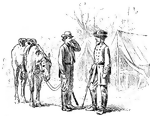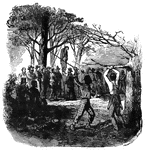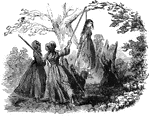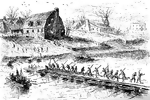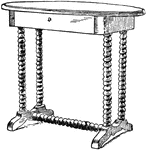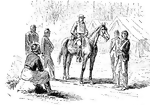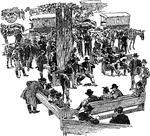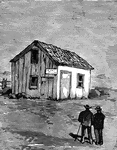The Miscellaneous Civil War ClipArt gallery includes 181 illustrations of general topic from the American Civil War, fought between the North (Union) and the South (Confederacy).
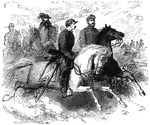
Federal Cavalry Leaders
"Federal Cavalry Leaders. Generals Pleasonton, Bayard and Colonel Percy Wyndham making a reconnoissance,…
Federal Fleet
"Panoramic view of the Federal fleet passing the forts of the Mississippi, on its way to New Orleans,…

Federal Prisoners
"Federal cavalry covering the escape of Federal prisoners from Libby Prison, Richmond, Va. The feeling…
!["First and last review of the First Regiment, South Carolina [African American] Volunteers, on Hilton Head, S. C., under Colonel Fessenden, U. S. A., June 25th, 1862. Our correspondent at Hilton Head wrote us: "I witnessed the parade entire, as well as the company drills in the manual of arms, etc., afterward, and I must acknowledge my complete surprise at the discipline and even vim evinced by the sable crowd. Dressed in the regulation uniform of the United States Army, tall and strong men generally speaking, they, considering that the regiment had not been fully armed but about ten days, spoke well for officers and men."" — Frank Leslie, 1896](https://etc.usf.edu/clipart/11000/11043/1stregiment_11043_mth.gif)
First Regiment
"First and last review of the First Regiment, South Carolina [African American] Volunteers, on Hilton…

Floating Battery
"Scene on the floating battery, Charleston Harbor, during the bombardment of Fort Sumter. A very important…

Foraging spoils
"Return of a foraging party of the Twenty-fourth Regiment, Connecticut Volunteers, with their spoils,…
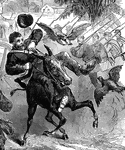
Foraging Spoils - Startled Horse
"Return of a foraging party of the Twenty-fourth Regiment, Connecticut Volunteers, with their spoils,…
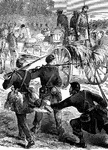
Foraging Spoils near Baton Rouge
"Return of a foraging party of the Twenty-fourth Regiment, Connecticut Volunteers, with their spoils,…
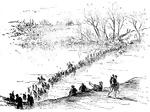
Ely's Ford
Civil War soldiers crossing Ely's Ford and the Rapidan river. Ely's Ford was a major battle of the river.…

Street in Fredericksburg
"A street in Fredericksburg, Va., showing the result of the bombardment- federal soldiers grouped about.…

John C. Fremont
(1813-1890) American explorer and soldier know as the Pathfinder who commanded Union forces in the Civil…

Cavalry of General Banks
"A reconnoitring detachment of General Banks's cavalry, Hyattstown, Md., in the distance. There are…
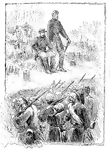
Civil War Generals
Soldiers passing Generals Grant (left) and George Meade (right). Meade is best known for defeating Robert…

Ironclad Georgia
"Confederate ironclad ram Georgia lying off Fort Jackson, Savannah River, Ga., December 1862."—…
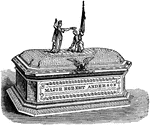
Gold Box Presented to Anderson
The gold box presented to Major Robert Anderson for his command of Fort Sumter during the American Civil…

Guarding Lancers
"Rush's lancers guarding the roads, the day after the Battle of Antietam, to prevent the passage of…

Company H
"Successful charge of Company H, first Massachusetts regiment (Captain Carruth), on a Confederate redan…
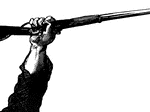
Hand with Gun
"Picture of a hand with a gun at the Battle of Munfordville, Ky., Sunday, September 14th, 1862- the…

Harrison's Landing
Harrison's Landing at Berkeley Plantation is one of the first great estates in America located on the…

Howlett's Battery
"Howlett's Confederate Battery on the James River, Va., shelling the Federal monitors and laborers on…
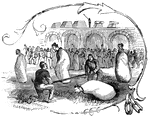
Hurdle Sack Race
"Federal soldiers participating in a hurdle sack race. Thanksgiving festivities at Fort Pulaski, Ga.,…

Delaware Indians
"Delaware Indians acting as scouts for the Federal army in the West. General Fremont, on taking command…

Delaware Indians
"Delaware Indians acting as scouts for the Federal army in the West. General Fremont, on taking command…
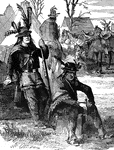
Delaware Indians
"Delaware Indians acting as scouts for the Federal army in the West. General Fremont, on taking command…

Delaware Indians
"Delaware Indians acting as scouts for the Federal army in the West. General Fremont, on taking command…
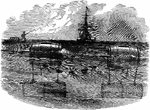
Infernal machine
"Infernal machine designed by the Confederates to destroy the Federal Flotilla in the Potomac discovered…

Battle of Island Number Ten
Bombardment and capture of Island Number 10 was an engagement at the New Madrid or Kentucky Bend on…

Campaign in Kentucky
"The campaign in Kentucky, Federal troops under General Johnston, advancing on the Louisville and Nashville…
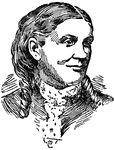
Lucy Larcom
Wrote many poems during the Civil War. Some of her published works include Wild Roses of Cape Ann…

Loading Gun
"Loading a 15-inch gun in the turret of an ericsson ironclad during the attack on Fort Sumter."— Frank…

locomotives
"Five locomotives built at Vicksburg, Miss., by the Federal soldiers, under the superintendence of Colonel…

Mahaska Crew
"The crew of the United States gunboat Mahaska, Captain Foxhall A. Parker destroying the water…

Captain Knott V. Martin's Pig
It is four o'clock in the afternoon when a messenger rides up to the house of Captain Knott V. Martin.…

Massachusetts Sixth Attacked When Marching Through Baltimore
The Massachusetts Sixth is the first to leave to save Washington from the Confederates. However, they…
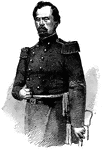
Irvin McDowell
(1818-1885) Soldier who served in the Mexican War and lead the Union Army in the Civil War at Bull Run
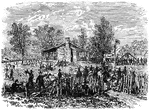
McPherson's Troops
"The war in Mississippi- McPherson's troops foraging at the Confederate General Whitfield's headquarters."—…

First Battle of Memphis
The First Battle of Memphis was a naval battle fought on the Mississippi River directly above the city…

Military authorities
"The military authorities at Washington, D. C., examining passes in 1861. This scene was of frequent…
!["Morning mustering of the 'Contrabands' at Fortress Monroe, on their way to their day's work. As a living illustration of one of the aspects of the Civil War, a sketch is given above of the contrabands, [African Americans], going to their daily work at Fortress Monroe. The variety of the Ethiopian countenance is capitally given, and while some remind us of the merry phiz of George Christy in his sable mood, others wear the ponderous gravity of a New Jersey justice. The [African American] men had a comparatively pleasant time under their state of contraband existence."— Frank Leslie, 1896](https://etc.usf.edu/clipart/12400/12451/mustering_12451_mth.gif)
Morning Mustering
"Morning mustering of the 'Contrabands' at Fortress Monroe, on their way to their day's work. As a living…
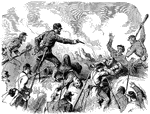
Lieutenant Colonel Morrison
"Heroic conduct of Lieutenant Colonel Morrison, Seventy-Ninth New York Highlanders, on the parapet of…

Mortar Battery Stanton
"Interior of the Mortar Battery Stanton, Tybee Island, Ga., showing the operation of 13-inch mortars…


